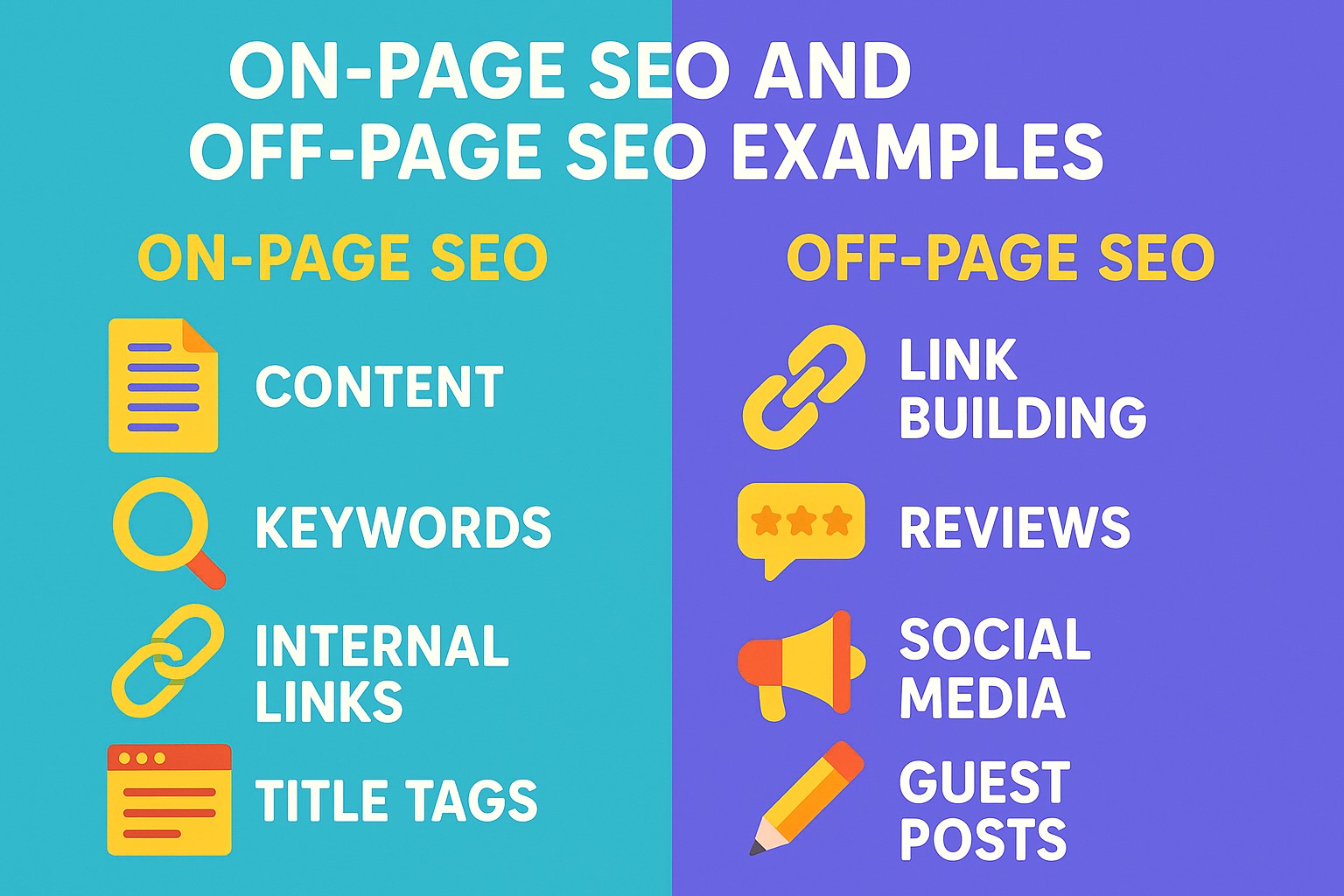On-Page SEO and Off-Page SEO Examples

Understanding how search engines work is essential to ranking higher in search results. Two major strategies dominate the SEO world: on-page SEO and off-page SEO. While both are important, they serve different purposes. On-page SEO focuses on optimizing elements within your website. Off-page SEO deals with building authority outside your site.
Let’s explore both types in detail with real, validated examples that show how you can boost your SEO performance effectively.
What Is On-Page SEO?
On-page SEO (also known as on-site SEO) refers to all the actions you take directly on your website to improve its position in the search engine results pages (SERPs). These include optimizing your content, meta tags, images, internal links, and even your site structure.
Example 1: Optimizing Page Titles and Meta Descriptions
One of the most basic yet critical on-page SEO techniques is writing keyword-optimized page titles and meta descriptions. Search engines use these elements to understand the page content.
Example:
A blog about sustainable farming could have the title:
“10 Sustainable Farming Techniques for Small Farms”
And a meta description like:
“Discover eco-friendly farming methods to increase your crop yield and protect the environment.”
This example uses keywords like “sustainable farming” and “eco-friendly,” which help both search engines and users understand the content.
Example 2: Using Header Tags Effectively
Header tags (H1, H2, H3, etc.) help organize your content for better readability and SEO. Your primary title should be in H1, while sub-sections can use H2 or H3.
Example:
In a tutorial article on baking bread, you might use:
-
H1: “How to Bake Homemade Bread”
-
H2: “Ingredients You’ll Need”
-
H2: “Step-by-Step Instructions”
These headers not only improve SEO but also user experience.
Example 3: Including Internal Links
Internal links guide readers to other relevant pages on your website, helping reduce bounce rates and increase time-on-site—factors search engines consider.
Example:
If you’re writing about “Digital Marketing Basics,” you can link to another article:
“Learn More: Understanding Content Marketing for Beginners.”
This keeps users on your site longer and signals that your content is valuable and interconnected.
Example 4: Image Optimization
Optimizing your images by adding relevant alt text, compressing image sizes, and using descriptive filenames improves load times and search engine accessibility.
Example:
An image showing a person using a compost bin could use the filename: composting-garden-waste.jpg and alt text: “Woman composting vegetable scraps in backyard.”
This helps with image search rankings and improves accessibility for screen readers.
Example 5: Keyword Optimization
Using keywords naturally throughout your content helps search engines determine relevance. Avoid stuffing your content with keywords—use them logically.
Example:
If the target keyword is “beginner yoga poses,” include it in:
-
Title: “Top 5 Beginner Yoga Poses for Daily Practice”
-
First paragraph
-
At least one subheading
-
URL slug (e.g.,
/beginner-yoga-poses)
These keyword placements boost your visibility for that term.
What Is Off-Page SEO?
Off-page SEO refers to techniques used outside your website to increase its authority and visibility. It’s mainly about building quality backlinks, increasing brand mentions, and improving social signals.
Example 1: Link Building Through Guest Blogging
Creating high-value content for other reputable blogs is a classic method of link building.
Example:
You write a guest article titled “The Importance of Organic Gardening” for a green living website and include a backlink to your article on “Top Organic Fertilizers for Home Gardens.”
That backlink tells search engines your site is trusted and relevant in the gardening niche.
Example 2: Social Media Engagement
Sharing your content on social media platforms helps generate traffic and brand recognition. While social signals are not a direct ranking factor, they influence visibility and engagement.
Example:
Posting a tutorial video about “How to Set Up a Hydroponic Garden” on a video-sharing platform and linking back to your blog post can increase traffic and encourage shares.
The more engagement your content gets, the more likely it is to earn backlinks naturally.
Example 3: Influencer Outreach and Mentions
Collaborating with influencers or industry experts can help you get mentions and backlinks from authoritative websites.
Example:
You run a sustainable food blog. You reach out to an eco-conscious nutritionist who mentions your “Zero-Waste Kitchen Tips” guide in their blog or newsletter. That mention boosts your domain authority and traffic.
Example 4: Online Reviews and Brand Mentions
Even if not linked, brand mentions on reputable sites and customer reviews help establish trust with search engines.
Example:
If your eco-product store receives dozens of positive reviews on third-party directories, search engines take this as a signal that your business is credible and user-friendly.
Example 5: Forum and Community Participation
Being active in relevant online communities builds awareness and backlinks over time.
Example:
On a gardening forum, you might answer a question about composting and include a helpful link to your in-depth guide on the topic.
As long as it’s valuable and non-spammy, this type of link can drive niche traffic and enhance off-page SEO.
On-Page vs Off-Page SEO: Key Differences
| Element | On-Page SEO | Off-Page SEO |
|---|---|---|
| Location | Inside your website | Outside your website |
| Control | You have full control | Limited control |
| Focus | Content, structure, keywords | Links, mentions, social shares |
| Goal | Improve relevance and user experience | Build authority and trustworthiness |
Both are essential. On-page helps you appear in search results; off-page helps you rank higher than competitors.
Why You Need Both
Focusing only on one strategy won’t give you optimal results. You could have the best content in the world (on-page), but if no one links to it or talks about it (off-page), your SEO potential is capped.
Likewise, strong backlinks won’t help poor content rank well. Search engines want to promote useful content backed by trust signals.
Final Thoughts
Effective SEO is about balance. On-page SEO gives your content structure and clarity. Off-page SEO builds your website’s reputation and authority. When combined, they form a powerful strategy for dominating search rankings.
Whether you’re a blogger, business owner, or marketer, applying both strategies consistently will help you grow your presence online, increase traffic, and boost conversions.
Key Takeaways:
-
On-page SEO includes content optimization, headers, internal linking, image tags, and keyword use.
-
Off-page SEO involves link building, influencer mentions, social media promotion, and customer reviews.
-
Use both strategies for long-term SEO success and higher search engine rankings.
References
https://en.wikipedia.org/w/index.php?title=On-page_factors&redirect=no
https://en.wikipedia.org/wiki/Off-page_factors
https://en.wikipedia.org/wiki/Search_engine_optimization
Links License – https://en.wikipedia.org/wiki/Wikipedia:Text_of_the_Creative_Commons_Attribution-ShareAlike_4.0_International_License
Dear Friends, invite You to click on the link below to discover some tech products from my blog. Thanks For Your Support.
https://techsavvo.com/category/tech-products/

